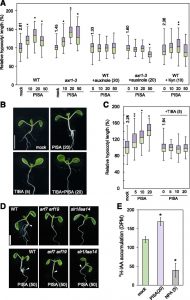Pinstatic Acid: a Novel Modulator of PIN Trafficking
The polar subcellular localization of the auxin efflux machinery determines the directionality of auxin flow in plants. In particular, the dynamics of polar localization of PIN proteins regulates the rate and direction of cellular auxin export and this ultimately determines auxin gradients in the tissue. Therefore, the regulatory machinery of the polarity and abundance of plasma membrane-localized PIN proteins is crucial for diverse developmental processes and morphogenesis including embryogenesis, initiation of lateral organs, and tropic responses. Auxin has been proposed to modulate its own transport by  regulating subcellular PIN trafficking via processes such as clathrin-mediated PIN endocytosis and constitutive recycling. To develop a useful chemical tool for dissecting the regulatory mechanism of PIN trafficking, Oochi et al. (10.1104/pp.19.00201) have screened phenylacetic acid derivatives for selective modulation of PIN trafficking in Arabidopsis. As a result, they have identified 4- ethoxyphenylacetic acid as a modulator of PIN cycling, and they have re-named it pinstatic acid due to its activity on PIN-mediated polar auxin transport. Pinstatic acid has an auxin-like effect on hypocotyl elongation and adventitious root formation by positively modulating auxin transport. Similar to conventional auxins, pinstatic acid blocks the internalization of PIN proteins from the PM and consequently induces PIN protein accumulation at the PM. Pinstatic acid is notably different from other known auxin chemical tools, such asauxin transport inhibitors 2,3,5‐ triiodobenzoic acid (TIBA) and N-1-naphthylphthalamic acid (NPA). As such, pinstatic acid represents a promising pharmacological tool for dissecting the complicated regulation of PIN trafficking by auxin.
regulating subcellular PIN trafficking via processes such as clathrin-mediated PIN endocytosis and constitutive recycling. To develop a useful chemical tool for dissecting the regulatory mechanism of PIN trafficking, Oochi et al. (10.1104/pp.19.00201) have screened phenylacetic acid derivatives for selective modulation of PIN trafficking in Arabidopsis. As a result, they have identified 4- ethoxyphenylacetic acid as a modulator of PIN cycling, and they have re-named it pinstatic acid due to its activity on PIN-mediated polar auxin transport. Pinstatic acid has an auxin-like effect on hypocotyl elongation and adventitious root formation by positively modulating auxin transport. Similar to conventional auxins, pinstatic acid blocks the internalization of PIN proteins from the PM and consequently induces PIN protein accumulation at the PM. Pinstatic acid is notably different from other known auxin chemical tools, such asauxin transport inhibitors 2,3,5‐ triiodobenzoic acid (TIBA) and N-1-naphthylphthalamic acid (NPA). As such, pinstatic acid represents a promising pharmacological tool for dissecting the complicated regulation of PIN trafficking by auxin.



